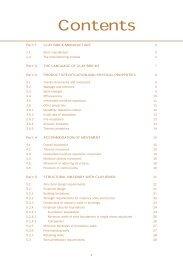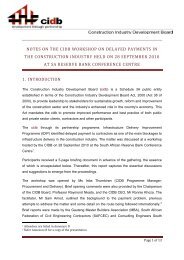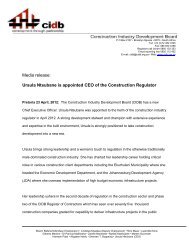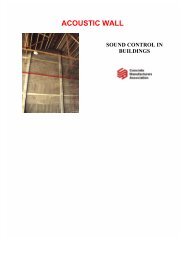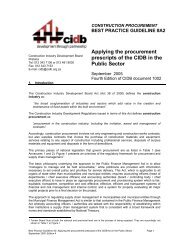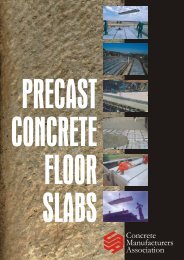MANUAL 4 - Construction Industry Development Board
MANUAL 4 - Construction Industry Development Board
MANUAL 4 - Construction Industry Development Board
You also want an ePaper? Increase the reach of your titles
YUMPU automatically turns print PDFs into web optimized ePapers that Google loves.
<strong>MANUAL</strong> 4 – BITUMINOUS PAVEMENT SEALS<br />
6.4 Application of binder for the seal<br />
6.4.1 Types of binder<br />
Emulsions are ideal for manual application as they do not have to be heated to temperatures<br />
of 130°C – 140°C as is the case for penetration bitumen.<br />
As they contain 35 – 40% water, the problem of over application, resulting in bleeding of the<br />
surface is overcome to a large extent.<br />
The following binders can be used for seal work:<br />
• Anionic spray grade emulsion (60% bitumen and 40% water).<br />
The viscosity of this binder is lower than the viscosity of a cationic emulsion, and the<br />
rate of application for a tack coat reduces to approximately 0,7 to 0,8 litres per m 2<br />
before the binder tends to flow, even when minimum gradients pertain.<br />
Generally they do not require heating unless the air temperature at the time of<br />
spraying is below 20 – 25°C.<br />
• Cationic spray grade emulsion ( 65% bitumen and 35% water).<br />
This emulsion is ideal for seal work. In cool weather it is advisable to heat the emulsion<br />
with a low flame to 50°C.<br />
Note<br />
The flow properties of this emulsion are better than Anionic emulsions.<br />
It is essential when using Cationic emulsion for the equipment to be thoroughly cleaned<br />
out of any Anionic emulsion. The equipment must be flushed out with water and paraffin.<br />
When heating Cationic emulsion, care must be taken to heat it with burners on a low<br />
flame, The temperature to which it is heated must not exceed 50°C.<br />
6.4.2 Rate of application of binder<br />
The amount of binder that is required per m 2 is dependent on the size of aggregate to be<br />
used (e.g. less binder is required for a 13 mm aggregate than for a 19 mm aggregate) and the<br />
spacing between the aggregate.<br />
It is therefore essential to determine the ALD of the stone before the quantity of binder can<br />
be determined.<br />
The amount of 60% or 65% emulsion for a single seal can be determined from Graph 4.2.<br />
IMPLEMENTING EMPLOYMENT INTENSIVE ROAD WORKS 69<br />
MODULE<br />
1<br />
2<br />
3<br />
4<br />
5<br />
6<br />
7





